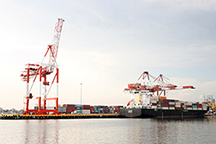

Manila South Harbor’s concessionaire and operator, Asian Terminals Inc. (ATI), has recently deployed an additional quay crane at the gateway port, bringing to nine its ship-to-shore cranes.
Aside from the new quay crane, ATI said it is deploying six more rubber-tired gantry (RTG) cranes this year, two of which would be ready to support the cargo-handling operations at South Harbor when assembly is completed in May.
The listed port operator said in a press release the acquisition of the crane from German crane maker Liebherr was part of its continuous boosting of operational efficiency and service reliability. The crane parts were delivered to Manila within just six months through DP World, ATI’s strategic foreign shareholder.
The new quay crane, capable of handling post-panamax ships with a 60-ton twin-lift capacity and a boom reach 16 containers wide, was deployed at the newly rehabilitated Pier 3, which was outfitted last year with extended crane rails and expanded back-up container storage areas.
Post-panamax ships denote vessels larger than those panamax vessels which fit the dimensions of the Panama Canal’s lock chambers, each of which is 33.53 meters wide, 320.04 meters long, and 12.56 meters deep.
“(With a complement of) three quay cranes at Pier 3, six quay cranes at Pier 5, a growing fleet of modern rubber-tired gantries and other container handling equipment, Manila South Harbor is primed to handle more and bigger ships at faster vessel and truck turnaround times,” ATI said.
Alongside the acquisition of more equipment, ATI is enhancing its yard footprint within the South Harbor expanded port zone to better manage the flow of containers.
ATI said it is continuously bolstering the operational capability and efficiency of both South Harbor and Batangas Port through process improvements, equipment acquisition and infrastructure development.




